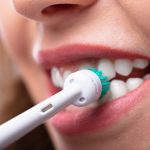What is the Right Chemistry for Toothpaste?
How to choose the right toothpaste, according to what’s in it
Toothpaste usually has a few key active ingredients: fluoride, whiteners, and baking soda. There are also all kinds of other ingredients you’ll see when you flip that label. So, what is the right mix? Is there a one-size-fits-all answer?
Dental enamel might be the hardest material in the body, but you still need to take care of it. Choosing a toothpaste is of utmost importance. You use your toothpaste every day, multiple times a day (or so we hope), so make sure that you are using the right stuff!
One of the best ways of getting the right toothpaste—without having to learn too much about pH balances and difficult chemical names—is to check the ADA requirements. Their key notes are:
- Toothpaste must contain fluoride
- Toothpastes may contain other active ingredients. These ingredients can do the following:
- Lessen sensitivity
- Whiten teeth
- Reduce gingivitis
- Reduce tartar build-up
- Prevent enamel erosion
- Prevent bad breath
- Flavoring agents that can cause tooth decay are not allowed in ADA-accepted toothpastes
- The toothpaste must be scientifically-proven to be safe and effective
Fluoride
Fluoride must be in toothpaste, which is good news since it’s beneficial in restoring enamel. Fluoride in toothpastes and drinking water has even been credited with a drastic reduction in cavities in the U.S. in recent decades. It is a proven, safe and effective ingredient.
However, consuming fluoride in large quantities can lead to problems in extreme cases. One of those is fluorosis, which is a staining of the teeth. It’s important for toothpastes to have fluoride for the dental benefits, but you don’t need to swallow it (so don’t).
If you have small children who might be swallowing a lot of toothpaste, here’s what you can do:
1) Make sure to use only use a pea-sized blob of toothpaste on their brush.
2) Reinforce spitting after they brush so they learn not to swallow.
3) Consider natural toothpastes. Many natural toothpastes are fluoride-free. If there is already fluoride in your water, your children should be getting enough to help prevent cavities.
Overall, however, you certainly want toothpaste with fluoride in it. It is a safe and effective way to prevent cavities. And that’s good news for everybody!
Baking Soda
Baking soda, or sodium bicarbonate, is a tooth whitener. Of course, it’s also used for baking! But we’re sticking to its dental application here.
Baking soda in toothpaste works in two ways. The first is that it’s a mild abrasive. The abrasive nature means it can scrub the teeth to remove particles and stains. The second is that baking soda is a natural alkaline. Alkaline chemicals reduce acidity. Bacteria on your teeth process sugar and make a resulting acid, which damages teeth and causes cavities. The alkaline nature of baking soda reduces this acidity, and makes it harder for bacteria to grow.
In general, baking soda isn’t a required element in toothpaste. It is good for whitening, so use a baking soda-heavy toothpaste if you want whiter teeth.
However, there can always be too much of a good thing. Frequently using baking soda as a toothpaste can damage your teeth. The mild abrasives in it can wear away at your enamel over time. Fortunately, most toothpastes don’t have enough baking soda to cause damage with everyday use. If you do use baking soda as a toothpaste, consider doing so only once or twice a week.
Other Common Ingredients
Saccharin
Saccharin is a sweetener. It’s often used in toothpaste for kids to make it taste better. It’s sugar-free, so it doesn’t cause tooth decay.
Tooth Whiteners
There are quite a few other whiteners that can be found in toothpaste. Usually they are also abrasives, which is how they work to whiten. Sometimes whiteners are alkaline as well. They include:
- Calcium Carbonate — an abrasive
- Silicates — an abrasive
- Hydrogen peroxide — bleaches stains, but can cause sensitivity in the mouth and gums
- Carbamide peroxide — also bleaches, but can cause mouth and gum sensitivity as well
Glycerol
This gives the toothpaste a smooth consistency, like a gel.
Sodium Lauryl Sulfate (SLS)
SLS is a foaming agent. It gives the toothpaste that pleasant, foamy feeling in the mouth.
Potassium Nitrate
This is an agent in desensitizing toothpastes. It decreases fluid flow through teeth tubules. Tubules are tiny holes or canals in the deep part of the teeth, beneath the gums. Potassium nitrate clogs the tubules, lowering the sensitivity of dental nerves.
Pyrophosphates
These chemicals help prevent tartar build-up. The bacteria on your teeth can collect, causing plaque. When this plaque hardens, it becomes tartar. Tartar is difficult to remove, and can contribute to gum disease.
Zinc Citrate
This also helps control tartar.
If you want a truly in-depth read on chemistry and home dental care, check out this 3-part article.
Choosing the Right Toothpaste for You
If you are an adult, with no serious dental problems or injuries, any ADA-approved toothpaste should be fine for you. However, if you have young children, you might want to avoid fluoride-heavy toothpastes if your children are still small. If you have sensitive teeth, something with potassium nitrate might be a good choice. The list goes on! If you want to find the best toothpaste for you, talk to your dentist.
Talk to a Dentist about the Best Toothpaste for You
If you are in the Fort Worth, Texas area, there is no one better than Dr. Ku, D.D.S. He is an award-winning dentist with decades of experience in the area. Dr. Ku also likes to keep on top of current dental trends and research, so he’d be happy to advise you on what toothpaste is perfect to fit your needs.






